(Wednesday, June 11) -- The puck went deep into the New Jersey zone with seconds remaining Monday night. The ultimate result had been a foregone conclusion for at least ten minutes if judging by the euphoria on the Devils' bench was any indication. The crowd at the Continental Airlines Centre had been on its collective feet for several minutes, chanting, 'We want the Cup! We want the Cup!' Ten�nine�eight�New Jersey players turned a blind eye to the scoreboard by this point, as gloves, sticks and helmets rained down on the perimeter of goaltender Martin Brodeur's crease. Brodeur had earned a shutout in the victory - his record-setting seventh of the 2003 playoffs and third of the final series. Only two others had ever earned three shutouts in a Stanley Cup final - Clint Benedict of the Montreal Maroons versus the Victoria Cougars in 1926 and the Toronto Maple Leafs' Frank McCool in defeating the Detroit Red Wings in 1945.
 |
| Cooper Smeaton is honoured with a plaque from Clarence Campbell during his induction to the Hockey Hall of Fame in 1961. |
On April 20, 1958, the Montreal Canadiens defeated the Bruins 5-3 in Boston to win the Stanley Cup. The visiting team's victory was greeted with a torrent of boos pouring down from the stands. Cooper Smeaton, one of the two Stanley Cup trustees, was appalled at the reaction of the Boston fans. In a letter to fellow trustee, Mervyn 'Red' Dutton, Smeaton wrote, "The behaviour of the fans at the end of the final game for the Stanley Cup in Boston last Sunday when the president of the league, Clarence Campbell, endeavoured to present the Cup, confirmed my thinking that no presentation should ever be made on the ice at the conclusion of any Cup series. After all, the Cup is the emblem of the World Championship and there should be some dignity in connection with the presentation. I think it should be done either at a public function such as a banquet, or a private dinner. In Boston, Senator Molson and Frank Selke tried to say something over the air but the (crowd was) making so much noise that they gave up and I think it was a downright disgrace. I fully realize the value of publicity if it is good, but I don't think the (negative fan reaction) such as on Sunday is good publicity and if proper policing of the crowd which would make it possible to have a dignified presentation is not possible, then it should be discontinued and made elsewhere."
Dutton, a former player and past-president of the National Hockey League, agreed. "I know exactly what you mean as I watched the game on television and the disregard for the ceremony of presenting the Stanley Cup has happened many times in the past."
Smeaton followed with correspondence that indicated, "I have discussed this matter with Mr. Campbell (NHL president Clarence Campbell) and he is fully in accord with our views. He says under no circumstances will he permit or have any part of presentation on the ice as he feels it does not provide the dignity that should go with the presentation of this Cup. I suggested that perhaps one of the best places to make the presentation would be at the All Star Game or the opening home game of the winning club."
NHL President Clarence Campbell mailed a letter to Frank Selke, the general manager of the Montreal Canadiens in September 1958. It stated, in part, "I had personally resolved that I would never undertake a public presentation of the Stanley Cup on the ice following the conclusion of a series again. Such an undignified spectacle contributes nothing to our game. I feel that the trophy should be ready and available for display immediately following the game under conditions that would insure that it would not be damaged in any way and that it should be presented to the winning team either in their dressing room afterwards or at a special victory dinner."
 |
| NHL President Clarence Campbell presents the Stanley Cup to Montreal captain Maurice 'Rocket' Richard. |
In 1960, the Montreal Canadiens won an unprecedented fifth Stanley Cup championship, although this victory took place at Maple Leaf Gardens in Toronto. Nonetheless, the Stanley Cup was presented by NHL president Clarence Campbell and Stanley Cup trustee Cooper Smeaton to Maurice Richard with Jacques Plante at his side on the ice in front of an appreciative and cheering Toronto crowd. The on-ice presentation of the Stanley Cup has become one of the most outstanding ceremonies in sport. Sold-out crowds in any city fortunate enough to host a Stanley Cup presentation are enthusiastic witnesses to a wildly emotional spectacle. It's the ultimate moment awaited by every hockey fan, passionate or passive.
The on-ice celebration has evolved exponentially through the decades. In the 1950's, it was a simple presentation to the winning team's captain by the NHL president. The captain would summon his team for a photograph standing around the table holding the Stanley Cup, then carry the championship trophy to the dressing room with a backdrop of applause from the fans. Exciting, new traditions have been adopted over the past two decades, a legacy to the leadership of NHL commissioner Gary Bettman. Families are now welcomed on the ice post-game to enjoy the Cup presentation. The Stanley Cup is ushered onto the ice with great fanfare by two executives from the Hockey Hall of Fame, wearing white gloves as they carry the 110-year old trophy down a red carpet to the spotlight at centre ice. Following the presentation of the Stanley Cup to the team captain by Mr. Bettman, each member of the team carries the Cup over his head, parading the trophy around the perimeter of the ice to the delight of the fans. At one point, the champions place the Stanley Cup on the ice surface, and the team huddles around their award for an impromptu team photograph. It's become legend. It's become the legacy of the Stanley Cup.
With Bon Jovi's 'It's My Life' serving as the soundtrack, the New Jersey Devils celebrated their victory on the ice surface of the Continental Airlines Arena. Player after player took a turn hoisting the Stanley Cup skyward. For some, like rookie Michael Rupp, it was their first exhilarating experience. For others, it was d�j� vu. Jamie Langenbrunner won the championship with the Dallas Stars in 1999, but found his second celebration every bit as wonderful as the first. "I didn't think you could duplicate this feeling after the first time, but this is unbelievable!"
When the New Jersey franchise first won the Stanley Cup in 1995, most of the team was young and the celebrations were exuberant. But in 2003, the boys are a little older and the celebration has taken on an entirely different complexion. Most are now married and raising young children. And although they are men, they still play a boys' game. As a result, parents are as evident as toddlers sporting red and black sweaters. This year, the on-ice celebration extended longer than usual. The players hoped it would never come to an end. It was no less a celebration than 1995, just that it was a different type of celebration. Slowly, led by their captain carrying the Stanley Cup, the players and their families dissolved to the dressing room, where chilled champagne waited. So did more media, and the Devils weren't hesitant to revel in their win. Neither were their families. Martin Brodeur's father Denis beamed as he proclaimed, "I'm so happy for Martin! He worked hard and deserved it a lot. He was on his game!"
 |
| The Stanley Cup was front page news in Wednesday's 'Record'. |
The Winner's Club, the suitably named restaurant at the Continental Airlines Arena, had been reserved for a private celebration for the team, their families and the Stanley Cup. Like the celebrations on the ice and in the dressing room, this party was fairly subdued too, but there was no happier spot on the face of the earth than this East Rutherford establishment. The party broke up late into the night, and the Stanley Cup remained locked in the Devils' offices overnight.
Tuesday was a quiet day. The Stanley Cup was the subject of a photo shoot for The Record, a New Jersey newspaper. The players celebrated privately, but discussions began as to whom would get the Stanley Cup, where they would be taking it and when. It's a labyrinth of logistics, but one of the favoured occupational hazards for Phil Pritchard at the Hockey Hall of Fame. He'll work in tandem with the New Jersey Devils and the National Hockey League in planning the travel itinerary for the Stanley Cup.
 |
| This block-long Hummer took the Devils and the Cup around New York Tuesday. |
The routing has already begun -- last night, many of the Devils took part in a team outing to Hoboken with the Stanley Cup. They rented a 32-foot white Hummer limousine and went out on the town to celebrate.
Today, the Stanley Cup is going back to school. Some of the players' children are taking the Stanley Cup to their classrooms for a memorable session of 'show and tell.' Tonight, the Stanley Cup will accompany some of the Devils to 'The Late Show with David Letterman.' Then tomorrow (Thursday), the day starts with Scott Stevens and the Stanley Cup on the set of 'Live with Regis and Kelly.' Afterwards, the Cup is returned to its case for a flight to Toronto and an appearance at the 2003 NHL Awards Gala at the Metro Toronto Convention Centre.
On Friday the 13th, return to this page to find out how David Letterman got lucky, and who had good luck at the NHL Awards.
Kevin Shea is a hockey journalist and historian living in Toronto.
|